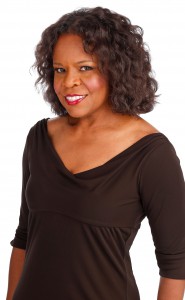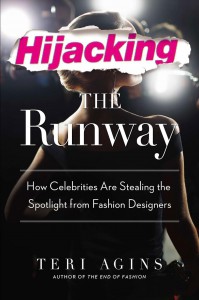By Mallory Hughes
“This is the end of fashion!”
Teri Agins, veteran fashion columnist for The Wall Street Journal and author of two books about the business of fashion, said this in 1999 after Giorgio Armani produced the first collection of men’s suits without lining to make them more comfortable.
In October, roughly 16 years later, Agins, The Wall Street Journal’s first fashion reporter, published her latest book, “Hijacking the Runway: How Celebrities Are Stealing the Spotlight from Fashion Designers” (Penguin Random House, $28). In it she explains how celebrities have simultaneously revolutionized and marginalized the art of style.
“Celebrities are making money doing more as a way to monetize fame,” Agins said in a recent, nearly two-hour interview about her book and the state of fashion. She provided an insider’s view of the industry’s evolution and anecdotal evidence to support her criticism of the growing role that celebrities play in the fashion world.

Agins has covered fashion for more than 25 years at The Wall Street Journal, and her writing has also appeared in Vogue and Harper’s Bazaar. She has received of the Eugenia Sheppard Award for Excellence in Fashion Journalism by the Council of Fashion Designers of America in 2004, and her first book published in 2000, “The End of Fashion: How Marketing Changed the Clothing Business Forever” (HarperCollins, $14.95), discusses how marketing changed the clothing business for good.
“The marketplace has gotten very crowded and the consumer can get confused,” she said. “What should they gravitate to?”
It is the fashion industry’s nagging imposters, the celebrities, who have the answer and show the consumer exactly what they didn’t know they needed, just by attaching their name to it.
Fashion has a long history of celebrities in other fields crashing its gates. In 1927, tennis player Rene Lacoste created the first fashion logo and celebrity line. He introduced the now-ubiquitous sport-shirt style because he was tired of playing tennis in uncomfortable clothes.
Thirty years later Givenchy launched a perfume, L’Interdit, using Audrey Hepburn’s classic image as a potent sales tool. In 1987, Elizabeth Taylor launched the first official celebrity fragrance, Passion, with estimated sales of more than $40 million in its second year, creating a fad that lasted well throughout the ‘90s.
But not until the advent of the Internet, Agins said, when millions of consumers around the world started following celebrities obsessively, did the trend catch fire.
“This is the end of fashion!”
– Teri Agins, 1999
In 2005, after semi-launching an unsuccessful jeans line, establishing a below-average acting career and stating the infamous “chicken or fish” line, Jessica Simpson partnered with Vince Camuto, who Agins referred to as “Mr. Shoe.”
“Of all people, she should’ve been the one to fail,” Agins said. “She went with the right guy. He turns this thing into something.”
And a whole bunch of something it was. Simpson’s shoe line, with prices ranging from $69 to $89, was a hit; it has since expanded to handbags, sportswear and more. It has become one of the most sought-after labels at Macy’s, bringing in about $1 billion in annual retails sales at the end of 2013.
“Even though they [consumers] had a negative impression [of Simpson], it shows they really wanted to buy,” Agins said. “It was the ultimate success.”
While some stars have followed suit, Madonna’s with her line at Kohl’s or the Kardashians’ at Sears, others celebrities’ designs made their way to the runways through a more traditional path.

(Penguin Random House/Courtesy)
Agins points to Victoria Beckham and the Olsen twins, Mary-Kate and Ashley. Yes, all three were famous long before they were fashion designers, but they were smart enough to start very small when they entered the fashion world.
“They knew they had to work for it,” Agins said. “And they wanted to be taken seriously.”
The luxury line by the Olsen sisters, The Row, is specifically tailored to the “golden-gated community of slender, affluent women who dreamed of owning the very best of the basics,” Agins wrote, with $260 T-shirts and $2,950 lambskin leather leggings. She estimated their 2013 annual retail sales to be more than $50 million.
“Those women bought that because they were interested in fashion,” Agins said. “Those women were not fans or interested in a little stardom.”
Department store labels, shoe lines, fragrances, handbags; the list of celebrity-influenced products is endless, making money and capturing consumers by the celebrity’s name alone. This is depressingly apparent to non-celebrity designers who have dedicated their entire careers to the craft.
“Here, you went to FIT [New York’s Fashion Institute of Technology] or Parson’s [School of Design in New York City] and you majored and had internships and were slogging away on 7th Avenue,” Agins said. “Hopefully you land on PR and even then, you’re still duking it out.”
That’s why she calls the celebrities hijackers, not designers.
But in general, their emergence has forced non-celebrity designers to create affordable lines as well as ultra-luxury collections. The presence of well-designed celebrity lines proves that “the best creators of fashion at every level can win,” Agins wrote.
And, as she wrote in her book, how can that possibly not be a good thing?


